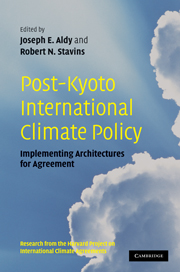Book contents
- Frontmatter
- Contents
- Harvard Environmental Economics Program, International Advisory Board
- Harvard Project on International Climate Agreements, Faculty Steering Committee
- Harvard Project on International Climate Agreements, Project Management
- List of figures
- List of tables
- List of contributors
- Foreword
- 1 Introduction
- Part I Alternative international policy architectures
- 2 An elaborated proposal for a global climate policy architecture: specific formulas and emission targets for all countries in all decades
- 3 The EU emission trading scheme: a prototype global system?
- 4 Linkage of tradable permit systems in international climate policy architecture
- 5 The case for charges on greenhouse gas emissions
- 6 Towards a global compact for managing climate change
- 7 Sectoral approaches to a post-Kyoto international climate policy framework
- 8 A portfolio system of climate treaties
- Part II Negotiation, assessment, and compliance
- Part III The role and means of technology transfer
- Part IV Global climate policy and international trade
- Part V Economic development, adaptation, and deforestation
- Part VI Modeling impacts of alternative allocations of responsibility
- Part VII Synthesis and conclusion
- Appendix A Selected List of Individuals Consulted, Harvard Project on International Climate Agreements
- Appendix B Workshops and Conferences, Harvard Project on International Climate Agreements
- Glossary and Abbreviations
- Index
3 - The EU emission trading scheme: a prototype global system?
Published online by Cambridge University Press: 05 June 2012
- Frontmatter
- Contents
- Harvard Environmental Economics Program, International Advisory Board
- Harvard Project on International Climate Agreements, Faculty Steering Committee
- Harvard Project on International Climate Agreements, Project Management
- List of figures
- List of tables
- List of contributors
- Foreword
- 1 Introduction
- Part I Alternative international policy architectures
- 2 An elaborated proposal for a global climate policy architecture: specific formulas and emission targets for all countries in all decades
- 3 The EU emission trading scheme: a prototype global system?
- 4 Linkage of tradable permit systems in international climate policy architecture
- 5 The case for charges on greenhouse gas emissions
- 6 Towards a global compact for managing climate change
- 7 Sectoral approaches to a post-Kyoto international climate policy framework
- 8 A portfolio system of climate treaties
- Part II Negotiation, assessment, and compliance
- Part III The role and means of technology transfer
- Part IV Global climate policy and international trade
- Part V Economic development, adaptation, and deforestation
- Part VI Modeling impacts of alternative allocations of responsibility
- Part VII Synthesis and conclusion
- Appendix A Selected List of Individuals Consulted, Harvard Project on International Climate Agreements
- Appendix B Workshops and Conferences, Harvard Project on International Climate Agreements
- Glossary and Abbreviations
- Index
Summary
Introduction
The European Union Emission Trading Scheme (EU ETS) can claim to be first in many respects. It is the first cap-and-trade system for greenhouse gases (GHGs) and it has resulted in by far the largest emissions trading market yet created. These attributes alone make the EU ETS worthy of study, but it is another first that provides the motivation for this chapter: The EU ETS is the world's first multinational cap-and-trade system. As such, it can be seen as a prototype for the multinational GHG emissions trading system that is often advanced as a possible architecture for an eventual global climate regime (Aldy and Stavins, 2008). While the EU ETS is in only its fifth year of existence, experience to date with this program provides a preview of the issues that are likely to appear in a global system, suggests some useful precedents, and offers evidence that some problems may not be so difficult after all.
Two important similarities
Two features make the EU ETS appropriate for study as a prototype for a global emissions trading system: the weak federal structure of the EU and the significant disparities in economic circumstance, institutional development, and political will that exist among its member states. The EU is not a strong federal union like the United States of America. Its member states are independent nations that display and exercise the principal attributes of sovereignty. While some authority in some domains has been ceded to central European institutions, the basic decision-making entity in the EU remains the Council of Ministers, which consists of the relevant ministers of the member states with carefully negotiated voting rights.
- Type
- Chapter
- Information
- Post-Kyoto International Climate PolicyImplementing Architectures for Agreement, pp. 88 - 118Publisher: Cambridge University PressPrint publication year: 2009
- 20
- Cited by

